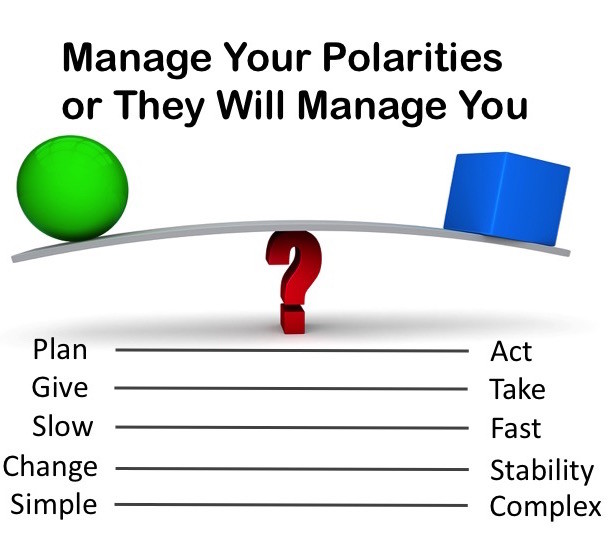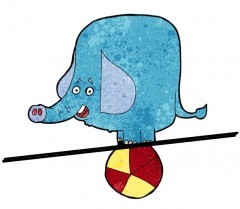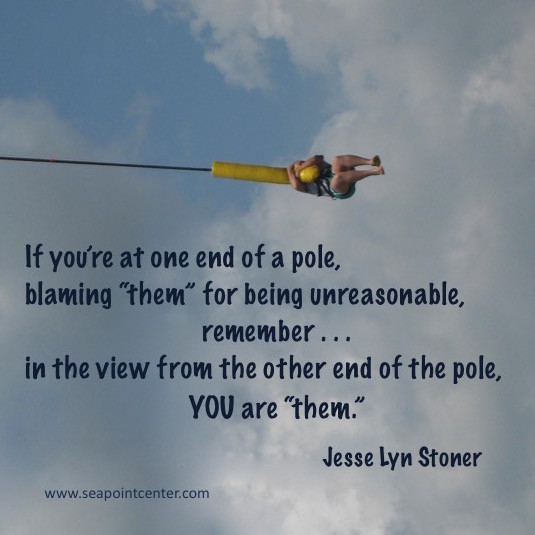Do you ever hear a little voice in the back of your head saying things like: look before you leap … or … two wrongs don’t make a right … or … if it ain’t broke, don’t fix it?
We all have tapes running in the background that guide our actions. If you pay attention, you might notice you’re often listening to sayings you learned as a child.
Many of these sayings contradict each other, lying at opposite ends of a pole. The pole you listen to depends on the family and cultural values you learned and the temperament you were born with.
Haste makes waste. <–> He who hesitates is lost.
You can’t teach an old dog new tricks. <–> You’re never too old to learn.
Ask for forgiveness instead of permission. <–> It’s better to be safe than sorry.
At which end of the pole do you hang out?
Most of us tend to hang out at one end of a pole or the other. You either prefer action or you prefer to plan. You are either results-oriented or process-oriented. You like to adopt new practices or prefer tradition and routine.
And, most people have little patience for those at the other end of the pole.
Where do you hang out on this pole?
There is an upside to each end.
If you are at the doing end, your “to do” list isn’t long because you get things done.
If you’re at the thinking end, you don’t make a lot of mistakes.
The problem is, there’s also a downside to each end.
If you’re at the doing end, you’re juggling a lot of balls. You might feel the weight of taking on too much, and some balls might get dropped.
If you’re at the thinking end, you might worry about all the things you haven’t gotten done, and you might miss opportunities.
Are you polarized – stuck at one end of a pole? Staying at one end of a pole too long surfaces the downside. It’s stressful and ineffective. If you don’t manage your polarities, they will manage you.
Bouncing reactively between the two ends is not the solution.
When the downside of hanging out at one end becomes too uncomfortable, many people flip to the other end.
But bouncing back and forth reactively, driven by stress and anxiety, can be crazy-making.
Finding balance is not the solution.
It might seem that the solution is to find balance – to hang out in the middle. But actually, not much gets done in the middle. You’re not taking action, and you’re not planning.
How can you get the upside of each end of the pole?
Learn to dance on the pole.
The solution is to move fluidly and intentionally on the pole.
How do you know when to move? Barry Johnson, author of Polarity Management: Identifying and Managing Unsolvable Problems, says to identify the early warning signals from the downside, and use them as an alert that it’s time to shift positions.
The place to start is to see the bigger picture that both ends of the pole support and to value both ends.
Try having a conversation with people hanging out at the other end. If you start with the assumption they have something to offer, you might not agree with everything they say, but chances are you’ll find something new that’s worth considering. You might discover some commonalities that are greater than your differences. And they might help you learn to dance on the pole.
Are you polarized?
If you are stuck at one end of the pole, blaming “them” for being unreasonable… remember, in the view from the other end of the pole, YOU are “them.”


















Love it.. you are so right about polarities. I never thought about it. And in reading, I instantly flashed on mom’s refusal to ask for help at her assisted living center and falling. She informed me “God helps those who help themselves.” I retorted back,”and pride goes before the fall!” She broke her kneecap. Your advice is well put. I am on the doing end of the pole and think I might do better at times to seek out my thinking friends before I start dancing.
Great example of how we use the tapes. Neither you nor your mother were ever going to change. The sayings were simply a way of arming yourselves to reinforce your positions. Sounds like you are interested in building your reflection muscles. They will certainly help improve your ability to dance. Thanks for weighing in, Eileen!
Hi Jesse
I hope that my offering makes sense and goes somewhat towards ‘dancing’ I am constantly considering and practicing MYCASKi, my personal reminder; and I am doing my very best to spread this reminder system to anyone that seeks to sustain their leadership journey. My focus is to encourage as many leaders as possible to utilize MYCASKI…ie if we all Make things happen and Make time for others, don’t dwell too much on Yesterday and really do want to make a difference, Challenge ourselves and are Confident, always Accountable and Allow others to grow, See and visualize our goals and objectives as well as Set an example, seek Knowledge and Know our limitations and are emotionally Intelligent and Integrate relationships…then I truly believe that it matters not one jot, what end of the pole we find ourselves. When you do find yourself diametrically opposed May I suggest a little sprinkling of MYCASKI all around. Even that voice in your head will start to take notice.
Thanks again Jesse for the stimulating insight…Kind Regards Raymond
Instead of thinking in terms of “either/or,” I believe managing polarities involves “and.” As a coach, here’s an exercise I often use with clients: 1) Stand at your preferred end of the spectrum and list all that is positive about being/doing from there. 2) Move to the opposite end of the spectrum, which is an unnatural place for you to stand, and list all of the negative perceptions you have about being/doing from there. 3) Go back to your preferred pole and note the downfalls of excessive being/doing from there. 4) Finally, return to the pole you’re less familiar with and determine how being/doing from there might counter the negative side of your pole of predilection. This exercise enables us to widen our scope by combining what is useful about both poles (“and”) rather than choosing one over the other (“either/or”). Clients learn they can be spiritual business leaders, conscious capitalists, heartfelt warriors, profitable and caring, vulnerable and courageous, and so much more. Funny how compatible polar opposites can be!
A good exercise for surfacing the upside and downside of each pole. And as you point out, it also helps widen the scope and reveal the bigger picture both ends support. Thanks for sharing, Kim.
This is an old topic for me as you know. I think the way you’ve laid it out with so many common but not understood as such, polarities, really hits home. A number of them were new to me and I’ve been working with these for 20 some years!
A few other thoughts… the greater an individual/team/organization’s ability to leverage the tension between two poles the greater their ability to leverage the energy that is contained in that polarity. Say for example we have a bow and arrow. Each end of the bow represents a pole. The larger the bow (read: the greater the distance between the ends of the bow/polarities) the further the arrow will fly.
There are also dozens of organizational polarities: centralizing AND decentralizing; business unit AND enterprise; long term AND short term and many more. We at Polarity Partnerships have developed a 5 Step Process to leverage any polarity called SMALL (it only take a SMALL bit of effort to get ALL the power of a polarity if you know what you’re doing). This goes beyond the post though I think it’ll be helpful for folks to know first, like you said, that they are SEEING a polarity. Next comes MAPPING which is a way to capture those upsides and downsides you also talk about above. Then there’s a new opportunity we’ve developed where you can ASSESS how well you’re doing leveraging a polarity and not for example, balancing it instead. Step 4 in the SMALL process is about LEARNING. What can the assessment tell us about well or poorly we’re doing with a particular polarity. What insights can we gain about what we’re doing that is giving us the energy in the polarity and what is getting in the way. Finally Step 5: Leveraging. This is about the Action Steps and Early Warnings you describe above Jesse. Learn more at http://www.polaritypartnerships.com
So glad you appreciated my post, Jake. My focus here was drilling in on personal polarities. Much thanks for sharing your extensive knowledge and widening the scope and depth. I have great respect for your work at Polarity Partnerships.
Quoting: “The place to start is to see the bigger picture that both ends of the pole support and to value both ends.” I like very much the notion of dancing on the pole! There’s no reason why the center of the pole should be any better than either end. Not enough of “either end” to be meaningful. Certainly we can get caught trying to plan for perfection, never doing anything because we cannot get to the perfect plan! And of course doing without any plan is disaster!!! So we do planning until we’re comfortable starting. AND we self-assess regularly to see how things are going, often revising the plan. Finally, at completion, we assess / reflect on satisfying the objective(s) and what we might do next time. As you suggest we dance up and down the pole!!!
Great example of what dancing on the pole looks like for the “Planning/ Doing” continuum. Thanks, John.